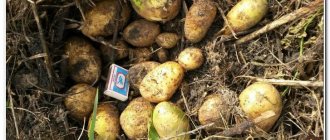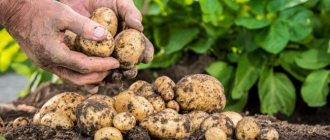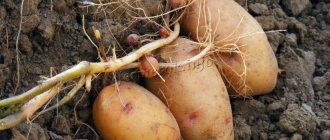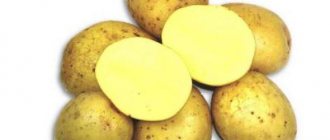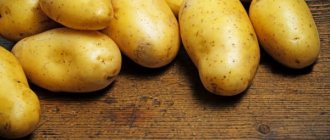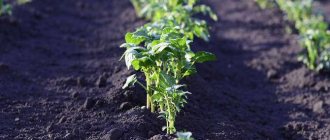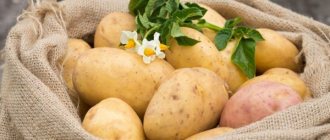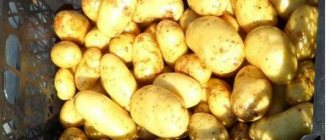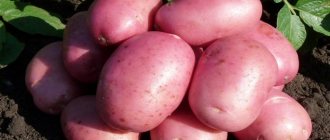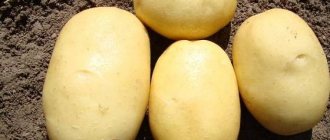Correct fit
Potatoes begin to be planted in late spring, when the soil has warmed up to a sufficient temperature. Indicators for planting crops can be:
- Soil temperature +9-10 C.
- Birch buds blooming.
If the conditions are met, you can begin planting.
Only the best tubers are selected as seed material. They must not be defective (cuts, stains, rot, etc.). Also, it is not recommended to use large or small potatoes. It is not advisable to cut it. The ideal planting material is whole tubers 70-80 g.
The landing pattern is standard. The row spacing is no more than 70 cm, the distance between holes is approximately 25-30 cm.
Lyubava potatoes are quite easy to care for. You only need to water it a few times, hill it up and fertilize it.
Fertilizer
The crop does not need fertilizer if:
- The soil is light and nutritious.
- Autumn fertilization was carried out.
Speaking of the second, it can completely satisfy all the needs of potatoes. An excess of nutrients can only lead to a deterioration in quality and yield.
But it often happens that the soil is too heavy or autumn fertilizing, for some reason, was not carried out. In this case, during planting of root crops, the hole is “directly” fertilized. Even before placing the tuber in the hole, wood ash or humus is added to it.
But as noted above, most often, autumn fertilizing of the site is quite sufficient.
Irrigation
Irrigation plays an important role in the development of culture. You need to water the potatoes, as they say, “rarely, but accurately.” Experienced experts recommend following the following irrigation scheme:
- The first watering should be carried out after the tops have grown by 10-15 cm. Earlier watering is prohibited.
- The second watering is when the first flowers appear on the tops.
- Third watering when the flowers have disappeared.
Naturally, you can increase the number of waterings. It depends on climatic conditions, amount of precipitation, etc.
What else is worth paying attention to? Experts also do not recommend watering Lyubava potatoes after flowering. Such an agrotechnical procedure can be harmful, increasing the risk of late blight
Hilling
Many gardeners treat this procedure with disdain, thereby not understanding its value. Hilling does not just keep the tops from sticking to the ground, it performs a number of important functions:
- As mentioned above, it holds the tops, preventing them from “falling” onto the ground. This, in turn, protects it from premature drying.
- Also, during hilling, the soil is loosened and saturated with oxygen. In the future, this plays an important role in the quality of the harvest.
- The last function of hilling is cleaning the area. This procedure removes weeds that inhibit potato development.
Hill up potatoes 2 times per season. The first time is when the tops have grown by approximately 20 cm. The second time, hilling is carried out as the green part grows. But usually it is carried out 15-20 days after the first hilling.
Potato growing technology
The Lyubava variety will give a good harvest on fertile, loose soil. If the soil is heavy, they try to improve its structure as much as possible before planting. Organic is best suited for these purposes. The bulk of the fertilizer is applied during the autumn digging of the garden. Manure, humus or compost will do. The amount of organic matter depends on the condition of the soil:
- light and fertile soil - 5 kg of organic matter per 1 m2 of land;
- heavy or infertile soil - at least 20 kg of organic matter per 1 m2 of land and additionally add 20 g of potassium and phosphorus.
During the second spring digging of the soil, organic matter is usually not added. If the soil is complex, compost with ash is added to the holes when planting tubers. In the spring, when digging up the garden, it is optimal to apply nitrogen-containing fertilizer to stimulate potato growth.
Preparation of seed potatoes, planting technology
Seed material is usually stored in the cellar. Summer residents practice storing a small amount of tubers in a box on the balcony. Regardless of the storage location, the tubers are sorted 2-3 weeks before planting. Leave whole, undamaged potatoes weighing 60-100 g.
Tubers are treated with a fungicide, since potatoes of the Lyubava variety are susceptible to scab. After drying, the seed material is laid out in a thin layer in a bright room with an air temperature of about +15°C. In such conditions, germination of planting potatoes occurs.
Planting is carried out when the average daily temperature outside is +10°C. Typically this period falls at the end of April - beginning of May. Standard landing pattern:
- leave a distance of 25-30 cm between the tubers;
- row spacing – 70 cm.
Can be planted in holes or grooves. If the soil is difficult, throw in a handful of compost, ash, add onion peels and crushed eggshells. The potatoes are sprinkled with a layer of soil 6-10 cm thick.
Potato care
Plant care begins from the moment shoots emerge. The gardener will have to perform standard procedures:
Due to hilling, Lyubava potatoes form stolons on which tubers develop.
- It is recommended to do the main abundant watering 3 times per season: when the tops grow to a height of 15 cm, before and immediately after flowering. However, in dry summers, the frequency of irrigation is increased. Sometimes you have to water the garden immediately after germination to prevent the sprouts from dying.
- The fertilizers applied in autumn and spring are usually sufficient. In case of poor soil or to obtain increased yields, fertilize before flowering. Each bush is watered with 2 liters of a solution prepared from mullein infusion or bird droppings.
- There are two main hillings: when the tops reach a height of 15 cm and before flowering. Sometimes a third intermediate hilling is carried out if the soil condition requires it.
Plantings must be treated against the Colorado potato beetle. The pest appears on potatoes every year. The fight against wireworms and mole crickets is carried out if signs of their presence are detected.
Lyubava potatoes are harvested on the 70th day, since the variety is considered early ripening. The tubers are dried under the shade, sorted, and sent to the cellar for storage. Optimal conditions for preserving the crop: temperature +5°C, humidity about 60-70%.
Description of the potato variety Lyubava
The Lyubava potato is a domestic variety, bred in the late 90s by the Siberian Federal Scientific Center for Agrobiotechnology (Novosibirsk) and the All-Russian Research Institute of Potato Farming (Moscow Region). The variety was included in the register of breeding achievements in 2003. It is unpretentious and produces a stable harvest in different climatic conditions. Recommended for cultivation in regions with short and unfavorable summers:
- Ural;
- Western and Eastern Siberia;
- Far East.
Main characteristics of Lyubava potatoes:
- early ripening - can be dug 45 days after germination;
- table – mass fraction of starch from 11% to 17%;
- medium height – 50–60 cm;
- plant of intermediate type.
The Lyubava potato bush is moderately spreading, semi-erect
The leaves are small, open, with slightly wavy edges. The color of the plate is rich green, the corollas are medium-sized, red-violet.
Lyubava potato tubers are large, oval-round in shape
The peel is rough, red in color. The eyes are noticeable and of medium depth. The mass of the tubers varies from 100 to 210 g, their diameter is 4–7 cm. The pulp is white, with a creamy tint, the taste is good: quite dense, boils slightly, does not darken either when heated or frozen.
Important! From 12 to 20 large tubers are formed on each bush. Product yield is 80–98%
Therefore, Lyubava potatoes can be grown both for personal use and for sale.
general characteristics
This is an early table variety. From the day the potatoes are planted in the ground until the tubers ripen, 60 to 75 days pass.
Attention!
The variety is considered high-yielding; one potato produces up to 20 smooth, large tubers.
Description of appearance and photo
- The bush is not too tall, compact. The shoots are erect.
- The leaves are small and dark. The edge of the leaves is slightly wavy.
- The flowers are red-violet, not numerous. Tubers are oval-shaped, red.
- The peel is a little rough. The pulp is white, dense, the cut does not darken in air.
Seeding rate and yield
The seeding rate of potatoes depends on the size of the tubers. If you take tubers weighing an average of 80 g for planting, then you will need 28 - 29 kg of seed tubers per hundred square meters. At summer cottages, gardeners adhere to the following calculation: 3 – 3.5 buckets per hundred square meters.
Important!
On large farms, seed consumption is calculated using special tables. On average, 2-2.5 tons per hectare are consumed for small tubers. If you take 80 g of tubers for planting, then for 1 hectare you will need approximately 4.5 tons of seed potatoes.
The yield of the Lyubava variety with good care is 300-400 kg per hundred square meters or 288-400 centners per hectare.
Taste characteristics
The Lyubava variety is famous for its excellent taste. It is perfect for frying and is delicious both boiled and baked. The tubers of this potato are easy to peel, as they have the correct shape and do not have deep eyes.
Chemical composition
- potassium;
- magnesium;
- phosphorus.
It contains a lot of vitamin C.
The starch content depends on the quality of the soil. On nutrient-rich soils, Lyubava potato varieties accumulate up to 17% starch. These tubers are more crumbly. On poor soils, starch in tubers forms from 11%.
Average tuber weight
The Lyubava variety is valued by gardeners for its large tubers of almost the same size. The weight of one tuber can reach from 110 to 200 grams.
Marketability
Smooth, red tubers have a very attractive presentation. The eyes of this potato are not deep. The size of the tubers is almost the same, so no additional sizing is required before sale.
Resistance to diseases and pests
Important!
Potatoes of the Lyubava variety are most susceptible to late blight. Can be affected by scab and fusarium
It is important to purchase seeds from trusted suppliers to avoid contamination of plantings with these fungal diseases
Of the pests, the Colorado potato beetle and root nematode add the most trouble. It is worth noting that the Colorado potato beetle prefers potatoes with more delicate leaves than those of the Lyubava variety. But if there are no other varieties on the site, it will also begin to feast on it. Therefore, preventive measures must be taken. Crop rotation and regular weeding save you from nematodes.
Keeping quality
The variety is also notable for the fact that, compared to other early potato varieties, its tubers do not wither or dry out until spring. No additional conditions are required for storage.
Consumer qualities
Despite their crumbliness, these potatoes do not get soggy when cooked. It is suitable for making chips. When frying, it holds its shape perfectly. Summer residents who grow this variety speak favorably of the taste of dishes prepared from Lyubava.
In what regions of Russia is it grown?
Fast ripening times make it possible to grow Lyubava in any climatic zones of our country. In the central zone and in the southern regions, two crops of potatoes of this variety can be harvested over the summer. Lyubava is well suited for regions with short summers - Siberia, the Urals and the Far East.
Diseases and pests
The variety has controversial immunity since Lyubava is not afraid of cancer, but is highly susceptible to late blight. Late blight, in turn, is a serious disease that can destroy most of the crop.
We recommend reading: “Description of the Ryabinushka potato variety”
Of the pests, the greatest danger to Lyubava are Colorado potato beetles. But fighting him is not too difficult. You can get rid of the parasite either manually or by treating it with insecticides.
General characteristics
Lyubava is an early ripening variety (55-70 days until full technical maturity). Has a table purpose. The short ripening period allows it to be grown in different climatic conditions. In the southern regions, you can harvest 2 crops during the summer. Suitable for growing areas with short summers (Far East, Siberia, Ural).
A little history
The Lyubava potato variety is the result of joint work by specialists from the Siberian Federal Scientific Center for Agrobiotechnology and the All-Russian Research Institute of Potato Farming named after. A.G. Lohra."
Since 2003, the variety has been included in the state register for 4 regions of Russia: Far Eastern, Ural, East Siberian and West Siberian.
Suitable for cultivation on personal farms and on an industrial scale. Has excellent indicators of transportability and safety.
General characteristics
The variety belongs to high-yielding varieties (approximately 300-400 kg per hundred square meters). Up to 20 potatoes are formed under one bush.
The tubers are large, oval, and of the same size. Weight reaches up to 200 g. It has an attractive commercial appearance. The eyes are not too deep. After harvesting, no additional calibration is required, since almost all root crops are the same size. The peel is red, slightly rough. When cut, the pulp is dense and white and does not darken for a long time.
The Lyubava variety is distinguished by not too tall bushes with erect stems. The bushes are compact with small leaves of bright green color. The leaves have a slightly wavy edge. The color is red-violet, not numerous.
Taste characteristics and chemical composition
Gardeners fell in love with Lyubava potatoes for many reasons: for high yields and good taste. Root vegetables can be used to prepare any dishes (frying, baking, boiling). Thanks to their regular oval shape, root vegetables are easy to peel.
The pulp contains many useful components:
- starch;
- phosphorus;
- potassium;
- magnesium.
The volume of starch depends on the soil in which it grows. On fertile nutrient soils, the starch ratio reaches 17%. Such root vegetables crumble during heat treatment. On poor, heavy soils, the starch level drops to 11%.
On a note! Despite their crumbliness, the potatoes do not fall apart when cooked. Suitable for making chips.
Reviews
Evgeny Vladimirovich, Saratov, 56 years old.
This variety (I haven’t seen others like it yet) has an individual feature. You can find up to 20 pieces in a hole. potatoes, all of them large. Thanks to this, the variety is highly productive.
Ivan Fedorovich, Baranovichi, 60 years old.
We have been growing Lyubava for a long time. Personally, I identified three positive qualities: productivity, early ripening and taste. If you grow potatoes, you can even get 2 harvests in 1 season. The taste is great too. I grow Rosara together with Lyubava, yes, Rosara is inferior, but still the taste is better than other varieties that I have tried over my long life.
Larisa Ivanovna, Kyiv, 45 years old.
Once upon a time Lyubava was grown. Productivity is like productivity, I don’t know why everyone praises it all the time. The potato is pink with a rough surface. The taste is excellent. It gets soft when cooked. I think a lot of people will like it.
Tatyana Viktorovna, Khimki, 51 years old.
We grow for sale. The tubers are huge, but very neat. Easy to transport, no damage. It is easy to sell on the market, as the root vegetables are beautiful and tasty.
Domestic potato varieties delight gardeners with excellent taste, ease of care, and high yields. The Lyubava variety is no exception. It is ideal for growing in any climate zone and attracts vegetable growers with its early ripening: tuber harvesting begins 60 days after planting. Moisture, heat and soil are the three main components to producing firm, neat, delicious potatoes.
The article will tell you what features the variety has, how to grow it and care for it.
Features of growing elite varieties
In terms of agrotechnical characteristics, most varieties differ little; there are minor differences in the timing of planting and care, but in general, in this part of the description they can all be combined into one group. Growing seed potatoes on your own is not an easy and too long process, taking from 3 to 5 years; you cannot do this without the necessary knowledge, and therefore it is more important to purchase it. The primary task is to decide on the choice of a specific variety, weighing all the pros and cons, and the place where you can safely buy potatoes for planting, taking into account the required quantity. Depending on the cultivated area, it is purchased wholesale or retail.
The entire sequence of actions from purchase to harvesting the first harvest is as follows:
- First of all, before planting in the ground, planting material requires preparation, which consists of germination - a simple but responsible process. Its goal is to obtain multiple sprouts, thick, 5-8 mm long - this is no longer desirable, they will break off when planted, this is not conducive to productive cultivation. To reduce the loss of shoots to a minimum, you should place the root vegetables in shallow boxes and place them in a bright, well-warmed place for a period of 3 to 4 weeks. There is no need to shift them; they can be transported as is; they can be planted directly from the boxes;
- No less attention must be paid to the selection and preparation of the site where Elite seed potatoes will be cultivated. It is better to take care of this in advance, ideally in the fall, although most of these varieties are not demanding on the composition of the soil. But a caring attitude will not harm them, especially since cultivation pursues breeding goals to ensure full planting next year. The soil should be enriched with mineral fertilizers applied in September-October, river sand, peat, compost or birch ash, immediately before planting;
- The requirements for the prepared site are simple: it must be plowed or dug up in the fall to a depth of 22-25 cm, cultivated in the spring, as soon as the snow melts and the soil dries out and is covered in order to retain moisture in it. It is necessary to remove all weeds, it is better not by weeding, but uproot them and throw them away from the site. Regardless of the degree of frost resistance and resistance to cold, planting is carried out only when the soil warms up to at least +9-110, this is determined by the evaporation emanating from the ground, distorting the picture of the surrounding landscape - the best evidence of the right time for planting;
- Before planting potatoes in the ground, you will need to treat them with a set of special means: to stimulate growth, protect against pests and possible diseases inherent to the crop as a whole, since this is not the strongest side of elite varieties. Such measures will bring a lot of benefits to the root crops being grown and will relieve gardeners from the need to process the green mass in the future in the fight against the Colorado potato beetle and other pests, which is much more troublesome. Drugs for these purposes are selected individually;
- It is not worth planting elite potatoes at great depths, a maximum of 12 or an average of 8-10 cm, so that the layer of soil covering the root crops is at a level of 6-8 cm. At greater depths, by May, when planting most often occurs, the earth is still poorly heated and does not reach the required temperature, but it is too damp - this will slow down growth. The distance between each of the pits or grooves is maintained within 40 cm, which is necessary for the tubers to grow in width at the moment they form. An indispensable condition is that each bush should receive as much sunlight and heat as possible;
- Most elite varieties are not demanding in care, rarely need feeding and watering, even during dry periods. The need for irrigation arises only when the crop is flowering - this is the most crucial moment when most procedures are carried out, the main one of which is hilling 2-3 times during the season. This measure is aimed at saturating the soil with oxygen - the only thing that potatoes really need, and protecting it from the influence of ultraviolet radiation. At the same time, it is necessary to ensure that both the tubers and the green mass remain healthy and are not attacked by pests that can destroy the entire crop.
Additional Information. The appropriate time for planting in each region is different and is not tied to a specific date. The folk way to determine it is quite simple - you just need to stand barefoot on the ground for 5 minutes; if your feet are cold, the time for planting has not yet come.
Advantages and disadvantages
The advantages of growing and disadvantages of the Lyubava variety are given in the table:
- early harvesting;
- simultaneous ripening of tubers;
- high productivity;
- presentation of tubers;
- good taste.
- low resistance to late blight of tops;
- high susceptibility to golden nematode.
Potatoes prefer medium to light soil. The culture grows well on sandy and sandy loam soils, loam and black soil. In clay soil, tubers develop slowly and are susceptible to rot.
The best predecessors for potatoes are beets, cabbage, cucumbers, and green manure. Planting the crop after tomatoes, peppers, potatoes and eggplants is not recommended.
Tubers are planted in April or May, depending on the weather conditions of the region. The soil should warm up well to a depth of 10 cm. Healthy tubers weighing about 80 g, without signs of rotting or damage, are selected for planting.
1.5 months before the start of work, potatoes of the Lyubava variety are kept in a bright place to stimulate the appearance of sprouts. When the sprouts reach a length of 1 cm, it is time to start planting. Immediately before planting, root crops are treated with Epin or another growth stimulant.
Tubers of the Lyubava variety are planted in holes or furrows. If the soil is heavy, root crops are deepened by 4-5 cm. Planting depth in light soil is 10 cm. 30 cm are left between tubers, rows are spaced every 70 cm.
Before the emergence of seedlings, caring for the plantings consists of loosening the soil. This way the tubers will receive more oxygen necessary for active growth of the root system. During loosening, weeds are removed. It is better to carry out the procedure after watering or precipitation.
When the first buds appear, intensive watering of the potatoes begins. Moisture is added as the top layer of soil dries. It is necessary to constantly keep the soil moist.
Under each bush add 2-3 liters of warm, settled water. Lyubava potatoes are watered in the evening, when there is no direct exposure to the sun. After watering, loosen the soil between the rows.
Hilling and feeding
Due to hilling, Lyubava potatoes form stolons on which tubers develop. The soil supports the shoots and prevents them from falling apart. When hilling, the soil is raked from the rows onto the potato bushes. For manual processing, forks are used; to simplify hilling, special equipment is used.
Hilling is performed twice per season:
- with a bush height of 15 cm;
- 2-3 weeks after the first treatment, before flowering begins.
Regular fertilizing ensures high productivity of the Lyubava variety. Treatment is carried out 2-3 times per season, taking into account the condition of the bushes.
The procedure for feeding Lyubava potatoes:
- when forming tops;
- during the budding period;
- 3 weeks before harvest.
The first feeding is necessary when the development of potatoes is slow. The need for fertilizer is indicated by thin stems and pale green leaves of the plants. For irrigation, prepare a solution enriched with nitrogen. It is best to use natural ingredients: bird droppings or manure.
For the second treatment of the Lyubava variety, a complex fertilizer is prepared containing 15 g of potassium sulfate and 30 g of superphosphate per 10 liters of water. The bushes are watered with a solution at the root. Processing stimulates the formation of tubers, improves their taste and keeping quality.
Feeding with phosphorus and potassium is repeated after flowering ends before harvesting. An alternative way to fertilize is to use any complex fertilizer for vegetables.
Productivity, collection and storage features
Potatoes can be harvested early. This is usually done 45-55 days after the sprouts appear. The crop yield is 28-40 kg per 1 sq.m.
Tubers should be dug up when the tops dry out and turn yellow.
At the same time, it is important to harvest the crop no later than 3 weeks after such manifestations occur.
If root vegetables are left in the ground for too long, their flavor profile will deteriorate. Also, untimely harvesting will adversely affect the transportability of potatoes.
After digging, the tubers should dry before the end of harvesting. After this, the potatoes should be kept in a dark shed for 2 weeks. During this time, disease symptoms will appear that will allow the potatoes to be sorted. Healthy tubers should be placed in a dry and cool place.
How to increase potato yield
A generally accepted technique is sprouting potatoes, as well as vernalization. To do this, the tubers are removed from storage approximately 30-35 days before the intended planting and placed in a bright, warm room. The potatoes should be exposed to the sun's rays, under the influence of which the tubers will turn green. They need to be carefully turned over from time to time so that vernalization occurs evenly, while being careful not to damage the sprouts.
This technique promotes the hardening of potatoes and the accumulation of solanine, a toxic substance, under the influence of light. Potatoes are less attacked by pests, acquire immunity and do not get sick. In addition, germination of tubers speeds up the time it takes for potatoes to emerge in the garden.
Soaking tubers in any growth stimulant gives good results. Various products are available for sale:
- Epin;
- Poteytin;
- Bioglobin.
The first two drugs are known to many, the third drug - Bioglobin - is a new generation composition. Bioglobin suspension can be combined with potassium permanganate, simultaneously stimulating sprouts and disinfecting tubers. Reviews indicate that treatment with growth stimulants not only awakens more sprouts in tubers, but accelerates the emergence of seedlings.
Potato variety Lyubava
It has many advantages, but if you don’t take care of planted potatoes, you won’t get a harvest.
Characteristic
The variety is early ripening, the ripening period of tubers is only 70 days. This short period guarantees a double harvest from one plot. If you need to get early potatoes, then the planting material is removed from the storage location in advance, since potatoes are germinated for 1.5 months.
Early ripening potatoes Lyubava
The unpretentiousness of the variety is also considered an important characteristic. Therefore, it can be planted on any soil.
Given the general drought in the region, the potato yield does not decrease much. Tubers form together and produce a large harvest. Yields of up to 524 centners per hectare were noted.
The variety is suitable for widespread cultivation.
Description
With proper care, the bushes reach medium height and the stems grow semi-erect. Blooms with red-violet flowers. The skin of the tubers is medium thick and red.
Potato color Lyubava
The tubers themselves are oval-shaped with rounded edges. The tuber rarely has eyes that lie on the surface. The average weight of tubers in one bush is 110-215 g. This variation in weight occurs due to uneven setting of tubers on the root system. The pulp is white and contains 14.5% starch.
The variety is for table use and is very good for preparing various home-cooked dishes.
Advantages and disadvantages
The tubers grow large, smooth, round-oval with appetizing white pulp that does not darken when cooked
It has many positive qualities among them:
- Excellent taste of tubers, both when boiling and when frying;
- Large tubers, uniform in size;
- The yield of marketable tubers reaches 95%;
- Early formation and ripening of fruits;
- Resistant to various diseases;
- Unpretentiousness to external natural stimuli;
- Drought resistant.
The only disadvantage is that potato plantings may be susceptible to golden nematode disease.
How to grow this variety
Cornflower is easy to grow and easy to care for
To get a high yield, it is important to correctly select seed material, prepare and fertilize the soil
Dates, scheme and rules of planting
Potato variety Cornflower is replanted in the middle or end of March, when there are no longer night frosts. Seed material is prepared starting from the last month of winter:
- For planting, potatoes of the correct shape are selected, without damage or signs of disease. The optimal weight of each is from 55 to 75 g.
- The tubers are evenly laid out in one layer for germination. It is advisable to sprinkle them with sawdust and irrigate them with water daily, using a spray bottle for this purpose.
- The day before, the seed material is treated with a solution of copper sulfate prepared from 10 liters of water and 1 tbsp. l. copper sulfate powder. This measure will protect potatoes from diseases.
- Having carried out preventive spraying, the tubers are dried and transferred to a warm, well-lit place, where they will warm up and germinate.
Cornflower is a light-loving variety. It is preferable to grow it in a garden area that is open to sunlight and protected from drafts.
Before planting, the soil is treated to create a comfortable temperature and air conditions. Organic fertilizers are added to heavy soil, and peaty-boggy soil is pre-cultivated.
It is advisable to plant in the ground where green manure previously grew. It is acceptable to grow Cornflower after beans, cabbage, cucumbers, and pumpkins.
Potatoes weighing 55–75 g are planted in accordance with one of the following schemes:
- 60×30 cm;
- 60×25 cm;
- 70×20 cm.
Care
To get a good harvest, it is important to follow the following recommendations:
- 14 days after planting, when shoots appear en masse, the inter-row space is loosened deeply (7 cm).
- If late spring frosts are predicted, the seedlings mount high.
- The first hilling is started when the tops reach a height of 15 cm, the second - when they close.
- Plants are watered as needed, and during the flowering period, when tubers are formed, they begin to actively water the bushes. 1 bush requires at least 2 liters of water.
- In drought conditions, mandatory irrigation is required. It is carried out at least 3 times during the growing season.
- When growing potatoes of the Cornflower variety, it is necessary to treat late blight with preparations with a high copper content. It is carried out at least 3 times per season.
- An alternative to regular weeding is mulching the soil. It reduces the growth rate of weeds and conserves moisture.
Cornflower potato plantings require fertilizing:
- a solution of bird droppings in a ratio of 1:10 to water;
- urea diluted in water 1:10;
- manure with water 1:10;
- fermented herbal infusions;
- phosphorus (foliar fertilizing).
Growing and care
The variety is drought-resistant, but requires watering for better yield.
Moisturizing is especially important during the flowering period, when the number of tubers depends on it. Irrigation is also necessary soon after germination and during periods of prolonged drought.
Warm water is used for irrigation.
Fertilizers are applied to the moist soil and hilling is carried out. Feed three times:
- Nitrogen fertilizer - after germination.
- Potassium and phosphorus - during budding.
- A mixture of organic matter and superphosphate - when flowering is over.
You need to hill up at a bush height of 10 cm, and again at 20 cm. They also regularly loosen the soil and fight weeds.
